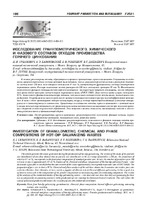| dc.contributor.author | Урбанович, Н. И. | |
| dc.contributor.author | Барановский, К. Э. | |
| dc.contributor.author | Розенберг, Е. В. | |
| dc.contributor.author | Дашкевич, В. Г. | |
| dc.contributor.author | Лугин, В. Г. | |
| dc.coverage.spatial | Минск | ru |
| dc.date.accessioned | 2021-09-10T13:34:23Z | |
| dc.date.available | 2021-09-10T13:34:23Z | |
| dc.date.issued | 2021 | |
| dc.identifier.citation | Исследование гранулометрического, химического и фазового составов отходов производства горячего цинкования = Investigation of granulometric, chemical and phase compositions of hot‑dip galvanizing wastes / Н. И. Урбанович [и др.] // Литье и металлургия. – 2021. – № 3. – С. 106-111. | ru |
| dc.identifier.uri | https://rep.bntu.by/handle/data/100795 | |
| dc.description.abstract | В статье рассмотрены отходы, образующиеся в процессе производства горячего цинкования. Результаты исследования гранулометрического состава цинковой пыли показали, что ее гранулометрический состав в размерном диапазоне частиц менее 250 мкм, доля которого составляет 87 мас. %, соответствует фракционному составу стандартного порошкового цинка. В изгари количество частиц размером до 250 мкм составляет примерно 35 мас. %. Исследования химического и фазового составов отхода горячего цинкования – цинковой пыли позволили установить, что по содержанию цинка отход примерно соответствует порошковому цинку (ГОСТ 12601). Доля чистого цинка в пыли составляет 95 %. Химический и фазовый анализы изгари показали, что она в своем составе имеет оксиды цинка, чистый цинк и хлориды цинка. Хлориды цинка в свою очередь могут являться поставщиком ионов хлора при термодиффузионном цинковании. В связи с этим представляет интерес использовать изгарь в составе порошковой композиции в качестве активирующего и цинксодержащего компонента. Проведенные исследования отходов горячего цинкования – цинковой пыли и изгари показали перспективность их применения в качестве компонентов в насыщающих смесях при получении цинковых покрытий химико‑термической обработкой. Это позволит снизить стоимость оцинкованных изделий и обеспечить рециклинг цинка в промышленный оборот. | ru |
| dc.language.iso | ru | ru |
| dc.publisher | БНТУ | ru |
| dc.title | Исследование гранулометрического, химического и фазового составов отходов производства горячего цинкования | ru |
| dc.title.alternative | Investigation of granulometric, chemical and phase compositions of hot‑dip galvanizing wastes | ru |
| dc.type | Article | ru |
| dc.identifier.doi | 10.21122/1683‑6065‑2021‑3‑106‑111 | |
| local.description.annotation | The article presents the waste generated during the production of hot‑dip galvanizing. The results of the study of the particle size distribution of zinc dust showed that its particle size distribution in the size range of particles ≤ 250 μm, the proportion of which is 87 wt. %, corresponds to the fractional composition of standard powder zinc. In ash, the number of particles up to 250 microns in size is approximately 35 wt. %. Studies of the chemical and phase composition of the hot‑dip galvanized waste – zinc dust made it possible to establish that the zinc content of the waste approximately corresponds to powder zinc (GOST 12601). The proportion of pure zinc in dust is 95 %. Chemical and phase analyzes of the ash have shown that it contains zinc oxides, pure zinc and zinc chlorides. Zinc chlorides, in turn, can be a supplier of chlorine ions in thermal diffusion galvanizing. In this regard, it is of interest to use ash in the composition of the powder composition as an activating and zinc‑containing component. The results of the analysis of the conducted studies of hot‑dip galvanizing wastes – zinc dust and soot show that they are promising for their use as components in saturating mixtures in the production of zinc coatings by chemical‑thermal treatment. This will reduce the cost of galvanized products and ensure the recycling of zinc into industrial circulation. | ru |

